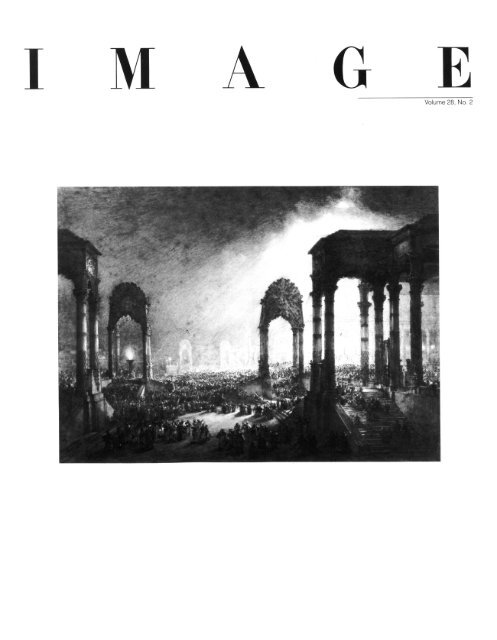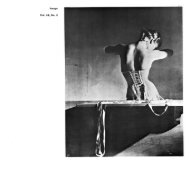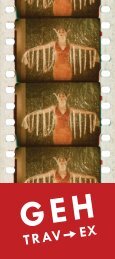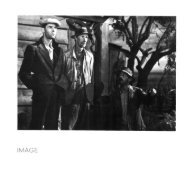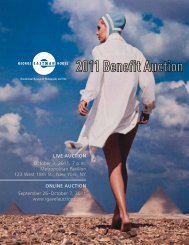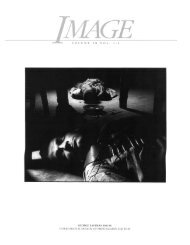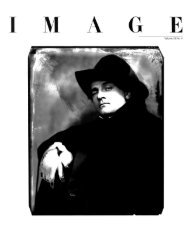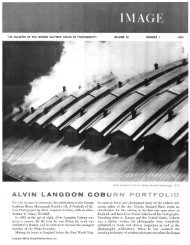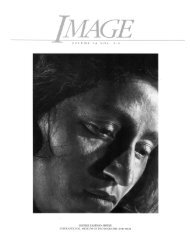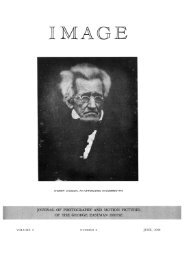Table of Contents - Issues of Image Magazine - George Eastman ...
Table of Contents - Issues of Image Magazine - George Eastman ...
Table of Contents - Issues of Image Magazine - George Eastman ...
You also want an ePaper? Increase the reach of your titles
YUMPU automatically turns print PDFs into web optimized ePapers that Google loves.
IMAGE • Vol. 28, No. 2 • June 1985<br />
Journal <strong>of</strong> Photography and Motion Pictures<br />
<strong>of</strong> the International Museum <strong>of</strong> Photography<br />
at <strong>George</strong> <strong>Eastman</strong> House<br />
<strong>Table</strong> <strong>of</strong> <strong>Contents</strong><br />
1 A Letter to Members <strong>of</strong> the International Museum <strong>of</strong> Photography at <strong>George</strong> <strong>Eastman</strong> House<br />
2 Daguerre: The Artist by Janet E. Buerger and David Kwasigroh<br />
Editorial Staff<br />
Robert A. Mayer, Director<br />
Robert A, Sobieszek, Director, Photographic Collections<br />
Janet E. Buerger, Associate Curator, Photographic Collections<br />
Marianne Fulton, Assistant Curator, Photographic Collections<br />
Heather Alberts, Curatorial Assistant, Photographic Collections<br />
Joanne Lukitsh, Curatorial Assistant, Photographic Collections<br />
Philip L. Condax, Director, Technology Collections<br />
Morgan Wesson, Assistant Curator, Technology Collections<br />
John B. Kuiper, Director, Film Collections<br />
<strong>George</strong> C. Pratt, Curator Emeritus<br />
Jan-Christopher Horak, Associate Curator, Film<br />
Allan Bobey, Assistant Curator, Film Preservation<br />
Andrew H. Eskind, Director, Interdepartmental Services<br />
Grant Romer, Conservator<br />
Barbara Hall, Public Relations Director<br />
Barbara Puorro Galasso, Darkroom Supervisor<br />
Board <strong>of</strong> Trustees<br />
Trustees<br />
Dr. Wesley T. Hanson, Jr.<br />
Chairman<br />
Georgia P. Gosnell<br />
Alan C. Hasselwander<br />
Thomas F. Judson, Jr.<br />
<strong>George</strong> S. Mclsaac<br />
Vice-Chairmen<br />
Paul L. Smith<br />
Treasurer<br />
Sue Stewart<br />
Secretary<br />
Robert A. Mayer<br />
Director<br />
Bruce B. Bates<br />
Colby H. Chandler<br />
Eugene C. Dorsey<br />
Walter A. Fallon<br />
Robert B. Frame<br />
Alexander D. Hargrave<br />
Douglass C. Harvey<br />
A. Arendt Hopeman III<br />
Harrison D. Horblit<br />
Frank M. Hutchins<br />
Nancy C. Kennedy<br />
Preston F. Kodak<br />
Richard L. Menschel<br />
J. Randall Plummer<br />
Richard M. Ross<br />
Harris H. Rusitzky<br />
Robert P. Schwartz<br />
Joanna T. Steichen<br />
Robert A. Taub<br />
Andrew D. Wolfe<br />
Trustees Emeritus<br />
Edward P. Curtis<br />
Mark Ellingson<br />
Sherman Farnham<br />
Vincent S. Jones<br />
William E. Lee<br />
Robert A. Sherman<br />
William S. Vaughn<br />
Marie Curran Wilson<br />
Honorary Trustees<br />
Berenice Abbott<br />
Walter Clark<br />
Andre Kertesz<br />
David H. McAlpin<br />
Beaumont Newhall<br />
IMAGE is published for members by<br />
International Museum <strong>of</strong> Photography at<br />
<strong>George</strong> <strong>Eastman</strong> House<br />
900 East Avenue, Rochester, NY 14607<br />
Copyright 1985 by International Museum<br />
<strong>of</strong> Photography at <strong>George</strong> <strong>Eastman</strong><br />
House. All rights reserved. Printed in<br />
U.S.A.<br />
COVER PHOTOGRAPH:<br />
Louis J. M. Daguerre. The Inauguration <strong>of</strong><br />
the Temple <strong>of</strong> Solomon, ca. 1836. Brown<br />
ink and wash study for the Diorama.<br />
Provenance: Gabriel Cromer Collection.<br />
Gift <strong>of</strong> <strong>Eastman</strong> Kodak Company<br />
Single copies <strong>of</strong> this issue are available at<br />
$4.50 each, plus postage.<br />
ISSN: 0536-5465
A Letter to Members <strong>of</strong> the International Museum <strong>of</strong> Photography at <strong>George</strong><br />
<strong>Eastman</strong> House<br />
In our last members' Newsletter, we were please to announce that the Museum had been given a piece <strong>of</strong><br />
valuable property by the <strong>Eastman</strong> Kodak Company to create an endowment for the future expenses <strong>of</strong><br />
operating the Museum's archives in Rochester.<br />
This places a great challenge on all those <strong>of</strong> us who care about these collections. The Kodak gift<br />
requires that we be ready to move into a "debt free" building by July 1989, just four short years from<br />
now, or lose the endowment. Our Board <strong>of</strong> Trustees will soon begin a Capital Campaign to raise funds<br />
to construct a building to house properly the collections. We hope that all <strong>of</strong> our members will join in<br />
this effort and give generously to such a campaign.<br />
Under the terms <strong>of</strong> the Kodak gift, however, the income from the endowment cannot be used for<br />
the archives operating expenses until we are ready to occupy such a facility. This could be three years<br />
or more away. In the interim the Museum will need to exercise budget restraint to live within our<br />
present income levels. This will mean temporary dislocation <strong>of</strong> some program activities, many <strong>of</strong><br />
which would most likely be resumed after the endowment income becomes available for archives<br />
operations. One <strong>of</strong> the areas in which we will need to temporarily reduce our activities is our<br />
publication program.<br />
We have been pleased to provide our members with an improved quarterly publication over the last<br />
several years. Since 1983 IMAGE has won twelve awards. We are proud <strong>of</strong> this achievement. However,<br />
we must make an effort to contain cost and will publish in 1985 only the first two issues <strong>of</strong><br />
Volume 28: No. 1, March 1985 (which you have already received) and this issue, No. 2. Beginning in<br />
1986, we will publish only one issue <strong>of</strong> IMAGE a year, until the financial status <strong>of</strong> the Museum permits<br />
a logical expansion <strong>of</strong> the publication program again.<br />
We are sure that you will understand this temporary measure. We want to thank you for your<br />
continued support <strong>of</strong> the Museum.<br />
Sincerely,<br />
Robert A. Mayer<br />
Director<br />
IMAGE • Volume 28 No. 2<br />
1
Daguerre: The Artist<br />
In Paris in 1839, when Louis Jacques Mande Daguerre announced the first practical photographic process to<br />
the public, the fame <strong>of</strong> the daguerreotype eclipsed his magnificent career as a painter. It is difficult<br />
to piece together his pre-photographic oeuvre. Only a handful <strong>of</strong> small works survive today, most <strong>of</strong><br />
them at <strong>George</strong> <strong>Eastman</strong> House. Until 1839 his reputation rested on his naturalistic stage designs<br />
(1816-22) and Diorama paintings (1822-39), but most if not all <strong>of</strong> these were destroyed by fire before<br />
his death in 1851. What is here is beyond value, and yet is only a pale reflection <strong>of</strong> the work that<br />
made him famous.<br />
His huge Diorama paintings were remarkable achievements <strong>of</strong> optical illusion. Shown to an audience<br />
seated in a darkened auditorium in a specially designed building, each scenic picture was larger<br />
in width than the Brackett Clark wing <strong>of</strong> the Museum. Each magically changed when carefully placed,<br />
filtered light "decomposed" one or the other <strong>of</strong> several superimposed atmospheric or time-lapse<br />
"effects" on the same canvas. Daguerre's genius dazzled connoisseur and public alike by combining<br />
the tricks <strong>of</strong> art and science, <strong>of</strong> fantasy and reality. He and his associate, Charles-Marie Bouton,<br />
received medals <strong>of</strong> the Legion <strong>of</strong> Honor when they exhibited small copies <strong>of</strong> Diorama subjects at the<br />
Salon.<br />
Daguerre was a key figure in the transformation from early nineteenth century Neo-Classic and<br />
Romantic Art, to mid-nineteenth century Realism. He drew attention to landscape painting and documentary<br />
work at a time when the Academy <strong>of</strong> Fine Arts favored history painting. A critically acclaimed<br />
popular artist, he penetrated the barriers <strong>of</strong> tradition with the scientific, pre-photographic<br />
temperament <strong>of</strong> his time. He foreshadowed Courbet, the Barbizon painters, Impressionism and<br />
photography, and prepared the way for the movies that were to come.<br />
Janet E. Buerger<br />
Associate Curator, Photographic Collections<br />
David Kwasigroh<br />
VSW/RIT Intern<br />
IMAGE • Volume 28 No. 2<br />
2
IMAGE • Volume 28 No. 2<br />
3
Art<br />
Daguerre was born in 1787 in Cormeilles-en-Parisis,<br />
not far from Paris. In 1804, after apprenticing to a<br />
local architect, he went to Paris where he studied in<br />
the studio <strong>of</strong> the celebrated Italian painter, who was<br />
then chief stage designer at the Paris Opera, Eugene<br />
Marie Degotti. He immediately experienced the huge<br />
panorama paintings that, opening that year, constituted<br />
the rage <strong>of</strong> Paris, and about 1807 became<br />
apprenticed to their author, Pierre Prevost, where he<br />
remained until 1816. During this period he showed<br />
at the Salon his "Interior <strong>of</strong> a Chapel <strong>of</strong> the Church <strong>of</strong><br />
the Feuillants, Paris" (now in the Louvre and represented<br />
in the <strong>Eastman</strong> House by an engraving).<br />
Many <strong>of</strong> Daguerre's early drawings and paintings<br />
exhibit a penchant for the naturalistic open-air<br />
approach, a concept that he would foster throughout<br />
his career and that would become popular later in<br />
the century with the Barbizon painters. None <strong>of</strong> the<br />
works in this section is directly related to his stage<br />
designs or Diorama paintings, but they collectively<br />
are our most important evidence for his fresh,<br />
accomplished technique. Because his own style was<br />
lost when his larger works were reproduced by<br />
surviving examples <strong>of</strong> engraving and lithography,<br />
these small drawings and paintings take on particular<br />
significance as we try to imagine the effect <strong>of</strong> his<br />
masterpieces on their audience.<br />
IMAGE • Volume 28 No. 2<br />
4
IMAGE • Volume 28 No. 2<br />
5
Voyages Pittoresques<br />
Lithography (printing from a stone with a drawing<br />
made from a greasy material) was discovered in<br />
Germany only at the end <strong>of</strong> the eighteenth century<br />
and was still a new, experimental art form in<br />
Daguerre's youth. Again, we find the young<br />
Daguerre in the vanguard. His "Entrance to the<br />
Church <strong>of</strong> the Holy Sepulcre" was published in 1819<br />
as part <strong>of</strong> le comte de Forbin's 78 plate Voyage dans<br />
le Levant (Voyage to the Orient). This was one <strong>of</strong> the<br />
most important <strong>of</strong> the early lithographic collections in<br />
France, gathering together, among the many early<br />
lithographic draftsmen, the co-inventors <strong>of</strong> the<br />
Diorama, Daguerre and Bouton.<br />
The most impressive lithographic publication,<br />
however, was Voyages pittoresques et romantiques<br />
dans I'ancienne France (Picturesque and Romantic<br />
Travels in Old France), a vast series <strong>of</strong> nearly 3,000<br />
plates issued in 20 odd volumes between 1820 and<br />
1878 by Baron Isidore Taylor, Charles Nodier and<br />
Alphonse de Cailleux. The Romantic movement is<br />
epitomized by the gothic ruins and travel views in<br />
Voyages pittoresques.<br />
IMAGE Volume 28 No. 2<br />
6
IMAGE • Volume 28 No. 2<br />
7
IMAGE • Volume 28 No. 2<br />
8
Theatre<br />
Daguerre's first real acclaim came in response to his<br />
stage designs in 1816-1822 for the Theatre de<br />
I'Ambigu-Comique and in 1820-1822 for the Opera.<br />
None <strong>of</strong> these works survive. From his master<br />
Degotti, Daguerre learned the spectacular Piranesitype<br />
oblique-angle design <strong>of</strong> the Italian Baroque<br />
stage. The revival <strong>of</strong> this style came as a great relief<br />
after the drab symmetrical work employed during<br />
the Revolution and Neo-Classical periods.<br />
At the Ambigu-Comique, Daguerre's designs<br />
received higher praise than the plays:<br />
"One seeks in vain for interest in Elodie, but as compensation,<br />
what pomp <strong>of</strong> spectacle, what decoration! Daguerre has<br />
surpassed himself, which seemed impossible."<br />
The apex <strong>of</strong> his theatre career came when he<br />
assisted Pierre-Luc-Charles Ciceri (1782-1868),<br />
successor to Degotti at the Opera. Their important<br />
1822 production <strong>of</strong> Aladdin or the Marvelous Lamp<br />
inaugurated a new opera building and initiated the<br />
use <strong>of</strong> gas lighting in the theatre. By dimming the<br />
auditorium and using new sources for his light,<br />
Daguerre revolutionized traditional stage design. His<br />
realistically executed final scene <strong>of</strong> the "Palace <strong>of</strong><br />
Light", with a moving sun effect, secured his reputation.<br />
Critics raved:<br />
"Never did the genius <strong>of</strong> Servandoni. . . or Degotti approach<br />
the marvels created by Daguerre". . . "We are no longer dependent<br />
on Italy for our decors. Today we surpass our masters."<br />
To Italian Baroque, Daguerre had added a magically<br />
darkened theatre, fantastic light effects, and trompe<br />
I'oeil naturalism—the sun itself included.<br />
IMAGE • Volume 28 No. 2<br />
9
The Diorama<br />
"(It) is not a vain representation—it is reality itself. . .<br />
"It was believed by thousands that the little boy in the foreground<br />
. . . was either a very quiet charity boy, or at least a suit<br />
<strong>of</strong> clothes stuffed, instead <strong>of</strong> the mere effect <strong>of</strong> the pencil."<br />
Of "Roslyn Chapel" they continued:<br />
"On viewing the Diorama (the visitors) might think themselves<br />
transported by some magic spell to the scene itself—so<br />
perfect was the illusion . . . An artist . . . declared that had he<br />
not clearly ascertained that the view . . . was a painting on a<br />
flat surface, he would have believed that the effect was produced<br />
by more than one position <strong>of</strong> scenery, or rather many scenes<br />
placed in different positions."<br />
Daguerre's most important pre-photographic<br />
achievement was his Diorama. In 1822, with Bouton,<br />
he opened an entire building for the exhibition <strong>of</strong> two<br />
45 1 /2 x 72 1 /2 foot canvases. Each was a marvel <strong>of</strong><br />
illusionistic painting, calculatedly designed<br />
according to the principles <strong>of</strong> physics so that, say, a<br />
red form would "decompose" when lit by red<br />
(filtered) light to reveal a different configuration or<br />
"effect" underneath.<br />
The Diorama—literally "two views" (or canvases)—<br />
showed one painting with an architectural view<br />
representing a man-made wonder, and then another<br />
with a scenic view representing a natural wonder.<br />
Daguerre presented a performance <strong>of</strong> varied<br />
"effects" for each <strong>of</strong> the two paintings. To the stock<br />
Romantic subject matter <strong>of</strong> architectural ruins and<br />
travel views, he added the illusion <strong>of</strong> reality. From a<br />
darkened auditorium, each view, though painted on<br />
a flat surface, looked large as life, naturalistic and<br />
three dimensional. Critics were struck with awe. Of<br />
Daguerre's "View <strong>of</strong> Brest Harbour" they exclaimed:<br />
10<br />
IMAGE • Volume 28 No. 2
IMAGE • Volume 28 No. 2<br />
11
IMAGE • Volume 28 No. 2<br />
12
IMAGE • Volume 28 No. 2<br />
13
IMAGE • Volume 28 No. 2<br />
14
IMAGE • Volume 28 No. 2<br />
15
The Double-Effect Diorama<br />
In 1834, with his student Sebron, Daguerre introduced<br />
the double-effect Diorama, which employed<br />
the front and the back <strong>of</strong> the canvas, and reflected<br />
and transmitted light, to present two quite different<br />
effects <strong>of</strong> the same view (day and night, a valley<br />
before and after an avalanche, an empty church and<br />
one filled with people). Often the changes in "effect"<br />
gave the impression <strong>of</strong> movement. In "The Inauguration<br />
<strong>of</strong> the Temple <strong>of</strong> Solomon", for instance,<br />
worshipers appeared gradually in the second<br />
"effect", giving the impression that they were moving<br />
from the background to the foreground. The principle<br />
<strong>of</strong> the double-effect is demonstrated in crude<br />
form by various nineteenth century optical toys such<br />
as the Polyorama Panoptique or the later photographic<br />
Megalethoscope, where two scenes <strong>of</strong> the<br />
same picture appear, depending on whether the<br />
viewer activates front or rear lighting.<br />
The Museum has a number <strong>of</strong> sketches relating to<br />
the Diorama paintings. These include Daguerre's<br />
"Inauguration <strong>of</strong> the Temple <strong>of</strong> Solomon" and<br />
Bouton's "Interior <strong>of</strong> Chartres Cathedral",<br />
"Edinburgh during the Fire <strong>of</strong> 1824" (painted by<br />
Daguerre), "Ruins <strong>of</strong> Fountains Abbey by Moonlight"<br />
(for the London Diorama) and "Fribourg" (for<br />
his own Diorama in Paris, built after Daguerre's<br />
burned in 1839).<br />
Bouton And Sebron<br />
Daguerre worked primarily with two associates:<br />
Charles-Marie Bouton, with whom he opened the<br />
Diorama; and Hippolyte Sebron, who created the<br />
double-effect Diorama with him.<br />
Of the two, Bouton is better known. Partly selftrained,<br />
like Daguerre, he worked—according to<br />
some accounts—with the famous neo-classical<br />
painter Jacques Louis David, and, like Daguerre, he<br />
collaborated with the panorama painter Prevost. His<br />
meticulous detail and precise perspective were<br />
excellently suited to Diorama work. From about 1823<br />
to 1840 he worked with the London Diorama as well.<br />
He returned to Paris to construct his own Diorama<br />
after fire destroyed Daguerre's in 1839. Throughout<br />
this period he was an active lithographic artist and<br />
easel painter but the popularity <strong>of</strong> his accurate style<br />
did not survive his death in 1853.<br />
Sebron trained with Daguerre, and travelled extensively<br />
to sketch material for the Diorama. He spent<br />
time in America, where he painted Niagara Falls and<br />
contributed the first Diorama to the New World.<br />
IMAGE • Volume 28 No. 2<br />
16
The Diorama In America<br />
The Paris Diorama was so popular that imitations<br />
appeared in the French provinces, in London, Berlin,<br />
Cologne, Breslau, Stockholm, and in various cities in<br />
America. In 1838 it made its first appearance in the<br />
United States in Philadelphia with a 2,000 sq. ft.<br />
"Crucifixion with the City <strong>of</strong> Jerusalem" painted by<br />
Daguerre's pupil, Sebron.<br />
"Daguerre's Real and New Diorama", made its<br />
debut in New York City in 1840, imported from Paris<br />
by Maffey and Lonati. The premier scenes were<br />
(Daguerre's?) "Midnight Mass at the Church <strong>of</strong><br />
St. Etienne du Mont at Paris", and (Bouton's?)<br />
"View <strong>of</strong> Venice on a Festival Night <strong>of</strong> the Carnival"<br />
Following the Parisian tradition <strong>of</strong> musical accompaniment,<br />
Mrs. Lonati assisted the painted performance<br />
on piano.<br />
From 1840 to 1843 the Diorama toured New York<br />
City, Philadelphia, Boston, Baltimore, Charleston,<br />
Washington, D.C. and New Orleans. There is<br />
evidence <strong>of</strong> a southern tour but exact locations are<br />
not known. The Diorama was to be shown in<br />
Havana, but it was destroyed in New Orleans by fire<br />
in 1843. New scenes created for America were not<br />
always the same monumental size as those for the<br />
European Diorama. No Diorama buildings appear to<br />
have been built (except in Philadelphia), so concert<br />
halls and large auditoriums served to house the<br />
productions.<br />
THE DIORAMA IN AMERICA: A CHRONOLOGY<br />
1838 PHILADELPHIA, Diorama Building, Sanson Street:<br />
"The Crucifixion, with the City <strong>of</strong> Jerusalem,"<br />
painted by Sebron<br />
1840-1841 NEW YORK CITY, Mr Lockwoods Rooms, 411 Broadway:<br />
Church St. Etienne du Mont, Midnight Mass<br />
(Daguerre and Sebron)<br />
View <strong>of</strong> Venice, Festival Night<br />
Paris under Charles IX<br />
St. Barthelemy<br />
Valley <strong>of</strong> Goldau (Daguerre and Sebron)<br />
1841 PHILADELPHIA<br />
1841 BOSTON, Concert Hall:<br />
Venice on Festival Night<br />
St. Etienne du Mont, Midnight Mass<br />
View <strong>of</strong> City <strong>of</strong> Constantinople<br />
Valley <strong>of</strong> Goldau<br />
Sicilian Vespers, or Palermo 1282<br />
1841 BALTIMORE, Assembly Room:<br />
St. Etienne du Mont, Midnight Mass<br />
Venice on Festival Night<br />
Valley <strong>of</strong> Goldau<br />
1842 WASHINGTON, D. C., Carusi's Assembly Room:<br />
St. Etienne du Mont, Midnight Mass<br />
Venice on Festival Night<br />
Valley <strong>of</strong> Goldau<br />
The Remains <strong>of</strong> Napoleon, in the Church <strong>of</strong> lnvalides,<br />
Paris, on 15th December, 1840<br />
1842 NEW YORK CITY, City Hall:<br />
The Remains <strong>of</strong> Napoleon<br />
St. Etienne du Mont, Midnight Mass<br />
View <strong>of</strong> Venice<br />
TOUR OF THE SOUTH<br />
1842-1843 NEW ORLEANS<br />
1st location—rear <strong>of</strong> Cathedral, opposite Orleans St.,<br />
2nd location-38 St. Charles St. (formerly the<br />
museum):<br />
Inauguration <strong>of</strong> Solomon's Temple (Daguerre and<br />
Sebron)<br />
Valley <strong>of</strong> Goldau<br />
Interior <strong>of</strong> St. Stephens Church, Paris<br />
Interior <strong>of</strong> Monastery <strong>of</strong> Mount Serrat, California<br />
Sicilian Vespers, or Palermo 1282<br />
St. Etienne du Mont, Midnight Mass<br />
View <strong>of</strong> Venice<br />
1843 Diorama burns in New Orleans<br />
IMAGE • Volume 28 No. 2<br />
17
IMAGE • Volume 28 No. 2<br />
18
IMAGE • Volume 28 No. 2<br />
19
Photography And The<br />
New Tradition<br />
In Daguerre's work we can see many prephotographic<br />
trends. In order to aid his naturalistic<br />
renderings he and his colleagues sketched with the<br />
aid <strong>of</strong> the camera lucida or camera obscura (devices<br />
that projected nature's image on the artist's paper for<br />
him to trace). Daguerre's desire to chemically fix the<br />
image <strong>of</strong> the camera led to experiments that resulted<br />
in his daguerreotype process. Since naturalism was<br />
their aim, Bouton's on-site sketches are barely<br />
distinguishable from later photographically-derived<br />
imagery.<br />
Daguerre's early travel views and his interest in the<br />
panorama and Diorama reflected the growing desire<br />
<strong>of</strong> early nineteenth century man to record every<br />
facet <strong>of</strong> Nature around him. Frederick von Martens,<br />
an engraver specializing in panoramic views, translated<br />
that interest directly into photography.<br />
Panoramic city views and landscapes would be<br />
among the earliest daguerreotypes made and would<br />
become a staple in photography for years to come.<br />
Scientists and explorers routinely armed themselves<br />
with both daguerreotype and material to make<br />
plaster casts, to enhance the accuracy <strong>of</strong> their<br />
recording technique. But the desire to copy nature<br />
could not be satisfied: optical toys, including stereographic<br />
views (drawn and photographic), would<br />
suggest the variation and three dimensional illusion<br />
so admired in Daguerre's Diorama.<br />
In Daguerre's work, illusion was based on a<br />
perfect combination <strong>of</strong> fantasy and reality, the artist<br />
and Nature working in full synchronization. It was he<br />
who discovered the real power <strong>of</strong> this apparently<br />
contradictory combination. The field <strong>of</strong> photography<br />
and photographic masters like Henri LeSecq inherited<br />
this power, and it remains to fascinate us today.<br />
ACKNOWLEDGEMENTS:<br />
This exhibition is deeply indebted to colleagues here and in<br />
Europe for their enthusiastic help.<br />
First, we thank Grant Romer <strong>of</strong> IMP/GEH, who inspired us with<br />
a small show on Daguerre in the late 1970s, and Helmut<br />
Gernsheim, whose book L. J. M. Daguerre is still the standard<br />
work. Among others, we were aided enormously by Stephanie<br />
Fronz <strong>of</strong> the University <strong>of</strong> Rochester Art Libraries; Barry Daniels<br />
<strong>of</strong> the Theatre Division at Kent State University; Bernard Marbot<br />
<strong>of</strong> the Bibliotheque Nationale in Paris; Jacques Foucart and Mlle.<br />
Landraud <strong>of</strong> the Musee du Louvre; Jeanne Roberts <strong>of</strong> the Historical<br />
Society <strong>of</strong> Pennsylvania; Elizabeth J. Miller <strong>of</strong> the Columbia<br />
Historical Society in Washington, D.C.; Stephen White <strong>of</strong> Los<br />
Angeles; Gerard Levy <strong>of</strong> Paris; Laurie Batie <strong>of</strong> the Maryland<br />
Historical Society; Roy Flukinger <strong>of</strong> the University <strong>of</strong> Texas,<br />
Austin; and Edward Morris <strong>of</strong> Merseyside County Council,<br />
Liverpool.<br />
As always, we relied heavily on our library, archives, registration,<br />
conservation, exhibitions and development departments,<br />
and on <strong>George</strong> Pratt for help in editing the labels. A special<br />
thanks is due Andrew Eskind and Philip Condax for their aid with<br />
the stereos and the Polyorama Panoptique.<br />
20<br />
IMAGE • Volume 28 No. 2
Corporate and Foundation Contributors<br />
Underwriters<br />
<strong>Eastman</strong> Kodak Co.<br />
Ford Motor Company Fund<br />
Gannett Foundation<br />
Gleason Memorial Fund<br />
IBM Corp.<br />
Lawyers Co-operative Publishing Co.<br />
The Andrew W. Mellon Foundation<br />
The Pew Memorial Trust<br />
Sponsors<br />
The Howard Gilman Foundation<br />
Patrons<br />
Access Rentals, Inc.<br />
Bausch and Lomb, Inc.<br />
Cortland L. Brovitz & Co.<br />
Case-Hoyt Corp.<br />
Citibank<br />
Computer Consoles, Inc.<br />
Curtice Burns, Inc.<br />
D. O. Industries, Inc.<br />
Holiday Inn<br />
Hopeman Brothers, Inc.<br />
Itek Graphic Products (Itek Corp.)<br />
Jones Chemicals, Inc.<br />
Kodak Camera Club<br />
Raymond LeChase, Inc.<br />
Marriott Corp.<br />
Money <strong>Magazine</strong><br />
Morgan Guaranty Trust Co.<br />
Photographic Historical Society, Inc.<br />
John B. Pike & Sons, Inc.<br />
Polaroid Foundation, Inc.<br />
Price Waterhouse<br />
RF Communications/Harris Corp.<br />
Rochester Clearing House Assoc.<br />
Central Trust Co.<br />
Chase Lincoln First Bank, N.A.<br />
Chemical Bank—Rochester Region<br />
Citibank (New York State), N.A.<br />
Key Bank <strong>of</strong> Western New York, N.A.<br />
Manufacturers Hanover, N.A.—Rochester Region<br />
Marine Midland Bank, N.A.—Rochester Region<br />
Monroe Savings Bank<br />
The Rochester Community Savings Bank<br />
Security Trust Company<br />
Rochester Gas & Electric Corp.<br />
Rochester Telephone Corp.<br />
Schlegel Corp.<br />
Sibley, Lindsay & Curr Co.<br />
Sybron Corp.<br />
J. Walter Thompson USA, Inc.<br />
Wilmorite, Inc.<br />
Xerox Corp.<br />
Young & Rubicam USA Foundation/Hutchins Y&R<br />
Benefactors<br />
Chase Lincoln First Bank<br />
Corn Hill Neighbors Assoc.<br />
Flanigan Furniture, Inc.<br />
Garlock, Inc.<br />
Genesee Brewing Co., Inc.<br />
Goldome<br />
I. Gordon Realty Corp.<br />
Gould Pumps<br />
Great Lakes Press<br />
Robert F. Hyland and Sons, Inc.<br />
Lovenheim Foundation<br />
Page Avjet Inc.<br />
Preferred Properties/Robert Bruce Lindsay Co., Inc.<br />
Rochester Acoustical Corp.<br />
Rumrill-Hoyt, Inc.<br />
Tapetex Products, Inc.<br />
Wegman's Food Market, Inc.<br />
Sustainers<br />
Arthur Andersen & Co.<br />
Canandaigua Wine Co.<br />
Carhart Photo, Inc.<br />
DeRidder/Thurston, Inc.<br />
Dolomite Products Co.<br />
Domine Builders Supply Corp.<br />
Erdle Perforating<br />
Forbes Products Corp,<br />
S. H. Gow & Co., Inc.<br />
LeCesse Brothers Contracting, Inc.<br />
Manitou Construction Co., Inc.<br />
Marsh and McLennan, Inc.<br />
Monroe Reprographics, Inc.<br />
Peat, Marwick, Mitchell & Co.<br />
The Pfaudler Co.<br />
Qualitrol Corp.<br />
RTR Transportation Corp.<br />
Riedman Foundation<br />
Rochester Asphalt Materials. Inc.<br />
Rochester Polychrome Press, Inc.<br />
Rochester Van & Storage Co. (Mayflower)<br />
Serv-Rite Food Service & Consulting Corp.<br />
Simcona Electronics Corp.<br />
Vanderlinde Electric Corp.<br />
Voplex Corp.<br />
Contributors<br />
Ailing and Cory Co.<br />
Burleigh Instruments, Inc.<br />
Caldwell Manufacturing Co.<br />
Harold J. Coleman Foundation<br />
Conifer Development, Inc.<br />
Cook Iron Store<br />
Coopers & Lybrand<br />
Credit Bureau <strong>of</strong> Rochester<br />
DeCarolis Truck Rental, Inc.<br />
Detection Systems<br />
Dollinger Corp.<br />
Doyle Detective Bureau, Inc.<br />
Emhart Corp.<br />
Exchange Genesee Associates<br />
Federated Department Stores Foundation<br />
Thomas W. Finucane Corp.<br />
First National Bank <strong>of</strong> Rochester<br />
Paul T. Freund Corp.<br />
General Cinema Corp.<br />
General Railway Signal<br />
Germanow-Simon Machine Co., Inc.<br />
T. H. Green Electric Co., Inc.<br />
Handler-Grosso<br />
Hansford Manufacturing Corp.<br />
Hatch-Leonard/Markin-Shaw. Inc.<br />
F L. Heughes&Co., Inc.<br />
Hickey-Freeman Co.<br />
Hickson Electric Corp.<br />
E. F. Hutton and Co., Inc.<br />
Hydroacoustics, Inc.<br />
IMPCO<br />
Kolko Paper Co., Inc.<br />
Labelon Corp.<br />
Janet Lehr, Inc.<br />
Light Impressions Corp.<br />
Logical Operations<br />
Lyons Development, Inc.<br />
Merrill Lynch, Pierce, Fenner & Smith<br />
Laurence Miller Gallery, Inc.<br />
Mixing Equipment Co,, Inc.<br />
Neikrug Photographica, Ltd.<br />
Otis Eastern Service, Inc.<br />
P.W.K.H. Wine Shop, Inc.<br />
Park-Meigs Association<br />
Marcuse Pfeifer Gallery, Ltd.<br />
Pittsford Travel Agency, Inc.<br />
James Stewart Polshek & Partners<br />
The Red Barn Gentlemen's Apparel, Inc.<br />
Red Carpet Travel<br />
Robfogel Mill Andrews Corp.<br />
Rochester Coca Cola Bottling Corp.<br />
Rochester Empire Graphics<br />
The Rochester Group<br />
Rochester Midland Corp.<br />
Peter J. Schmidt Co., Inc.<br />
Schuler-Haas Electric Corp.<br />
Scrantoms Book & Stationery Co.<br />
Sloan & Co., Inc.<br />
Snyder, E. G. Co., Inc.<br />
Society <strong>of</strong> Photographic Scientists & Engineers<br />
Staples & Charles, Ltd.<br />
The Textron Charitable Trust<br />
Town & Country Dry Cleaners<br />
Arthur V. Towner, Inc.<br />
VIC & IRV, INC.<br />
Visual In-Seitz, Inc.<br />
Waste Management, Inc. (H<strong>of</strong>f Bros.)<br />
Werner Spitz Construction<br />
Stephen White Gallery <strong>of</strong> Photography, Inc.<br />
Wilson, Klaes. Brucker & Worden, P.C.


